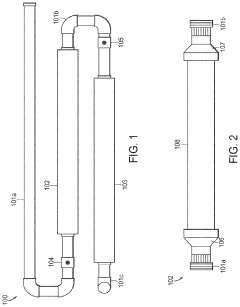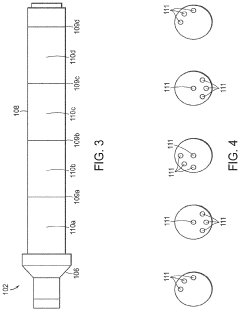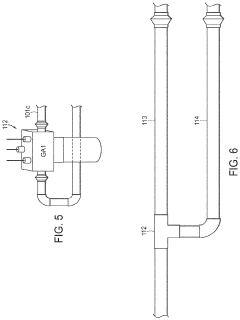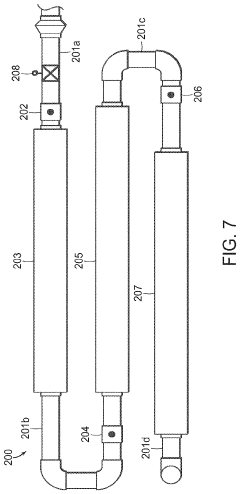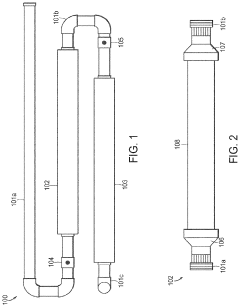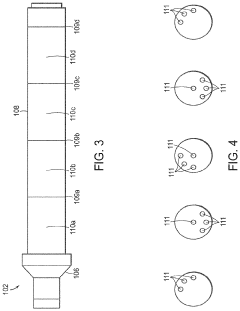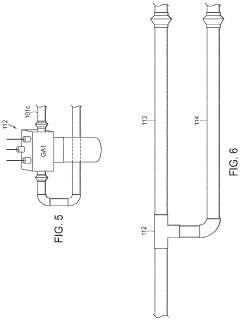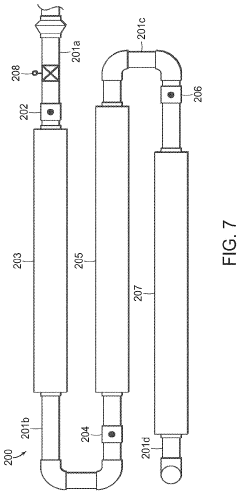Hypochlorous Acid in Biofilm Control: A Research Perspective
AUG 4, 20259 MIN READ
Generate Your Research Report Instantly with AI Agent
Patsnap Eureka helps you evaluate technical feasibility & market potential.
HOCI Biofilm Control Background and Objectives
Hypochlorous acid (HOCl) has emerged as a promising agent in biofilm control, attracting significant attention in both scientific research and industrial applications. The development of HOCl as a biofilm control method stems from the growing need for effective, safe, and environmentally friendly solutions to combat microbial colonization in various settings.
Biofilms, complex communities of microorganisms adhering to surfaces and encased in a self-produced extracellular matrix, pose significant challenges across multiple sectors. These resilient structures can form on diverse surfaces, from medical devices to industrial equipment, leading to persistent infections, reduced efficiency, and increased operational costs. Traditional methods of biofilm control often involve harsh chemicals or antibiotics, which can be harmful to human health and the environment, and may contribute to antimicrobial resistance.
The exploration of HOCl in biofilm control is rooted in its natural occurrence in biological systems. As a key component of the human immune response, HOCl is produced by neutrophils to combat pathogens. This inherent biocompatibility has sparked interest in harnessing its antimicrobial properties for broader applications.
The primary objective of research into HOCl for biofilm control is to develop a highly effective, yet safe and sustainable solution for managing microbial biofilms. This involves understanding the mechanisms by which HOCl interacts with biofilm structures, optimizing its production and application methods, and evaluating its efficacy across different environmental conditions and microbial species.
Key research goals include elucidating the molecular interactions between HOCl and biofilm components, such as extracellular polymeric substances (EPS) and cellular membranes. Additionally, researchers aim to determine optimal concentrations and exposure times for effective biofilm disruption while minimizing potential adverse effects on surrounding tissues or materials.
Another critical aspect of HOCl research in biofilm control is the development of stable formulations and delivery systems. HOCl is known for its instability, which can limit its practical applications. Therefore, a significant focus is placed on enhancing its shelf life and developing methods for on-site generation or controlled release.
The potential applications of HOCl in biofilm control span various industries, including healthcare, water treatment, food processing, and industrial manufacturing. In healthcare, HOCl shows promise in wound care, dental hygiene, and the disinfection of medical devices. In water treatment, it could offer an alternative to traditional chlorination methods, potentially reducing the formation of harmful disinfection by-products.
As research progresses, the overarching aim is to establish HOCl as a versatile, eco-friendly, and cost-effective solution for biofilm management, addressing the growing global concern over biofilm-related issues while aligning with sustainable practices and regulatory requirements.
Biofilms, complex communities of microorganisms adhering to surfaces and encased in a self-produced extracellular matrix, pose significant challenges across multiple sectors. These resilient structures can form on diverse surfaces, from medical devices to industrial equipment, leading to persistent infections, reduced efficiency, and increased operational costs. Traditional methods of biofilm control often involve harsh chemicals or antibiotics, which can be harmful to human health and the environment, and may contribute to antimicrobial resistance.
The exploration of HOCl in biofilm control is rooted in its natural occurrence in biological systems. As a key component of the human immune response, HOCl is produced by neutrophils to combat pathogens. This inherent biocompatibility has sparked interest in harnessing its antimicrobial properties for broader applications.
The primary objective of research into HOCl for biofilm control is to develop a highly effective, yet safe and sustainable solution for managing microbial biofilms. This involves understanding the mechanisms by which HOCl interacts with biofilm structures, optimizing its production and application methods, and evaluating its efficacy across different environmental conditions and microbial species.
Key research goals include elucidating the molecular interactions between HOCl and biofilm components, such as extracellular polymeric substances (EPS) and cellular membranes. Additionally, researchers aim to determine optimal concentrations and exposure times for effective biofilm disruption while minimizing potential adverse effects on surrounding tissues or materials.
Another critical aspect of HOCl research in biofilm control is the development of stable formulations and delivery systems. HOCl is known for its instability, which can limit its practical applications. Therefore, a significant focus is placed on enhancing its shelf life and developing methods for on-site generation or controlled release.
The potential applications of HOCl in biofilm control span various industries, including healthcare, water treatment, food processing, and industrial manufacturing. In healthcare, HOCl shows promise in wound care, dental hygiene, and the disinfection of medical devices. In water treatment, it could offer an alternative to traditional chlorination methods, potentially reducing the formation of harmful disinfection by-products.
As research progresses, the overarching aim is to establish HOCl as a versatile, eco-friendly, and cost-effective solution for biofilm management, addressing the growing global concern over biofilm-related issues while aligning with sustainable practices and regulatory requirements.
Market Analysis for Biofilm Control Solutions
The biofilm control solutions market has been experiencing significant growth in recent years, driven by increasing awareness of the detrimental effects of biofilms across various industries. The global market for biofilm control solutions is expected to continue its upward trajectory, with a compound annual growth rate (CAGR) projected to remain strong through the next decade.
Key factors contributing to market growth include the rising demand for effective antimicrobial solutions in healthcare settings, water treatment facilities, and industrial processes. The healthcare sector, in particular, has been a major driver of market expansion, as hospitals and medical facilities seek to combat healthcare-associated infections (HAIs) caused by biofilm-forming pathogens.
In the industrial sector, biofilm control solutions are gaining traction in food and beverage processing, oil and gas production, and paper manufacturing. These industries face significant challenges related to equipment fouling, product contamination, and reduced operational efficiency due to biofilm formation. As a result, there is a growing demand for innovative and cost-effective biofilm control technologies.
The water treatment industry represents another substantial market segment for biofilm control solutions. Municipal water systems, cooling towers, and desalination plants are increasingly adopting advanced biofilm control methods to ensure water quality and system efficiency. This trend is expected to continue as water scarcity issues and stringent regulations drive the need for more effective water management practices.
Geographically, North America and Europe currently dominate the biofilm control solutions market, owing to their well-established healthcare systems and stringent regulatory frameworks. However, the Asia-Pacific region is anticipated to witness the fastest growth in the coming years, fueled by rapid industrialization, increasing healthcare expenditure, and growing awareness of biofilm-related issues.
The market landscape is characterized by a mix of large multinational corporations and smaller specialized companies. Key players are focusing on research and development to introduce novel biofilm control technologies, with a particular emphasis on environmentally friendly and sustainable solutions. This trend aligns with the growing consumer preference for eco-friendly products and regulatory pressures to reduce the use of harsh chemicals.
Hypochlorous acid (HOCl) has emerged as a promising solution in the biofilm control market, attracting attention due to its high efficacy and low toxicity profile. The increasing interest in HOCl-based products is expected to create new opportunities for market growth and potentially disrupt traditional biofilm control methods.
Key factors contributing to market growth include the rising demand for effective antimicrobial solutions in healthcare settings, water treatment facilities, and industrial processes. The healthcare sector, in particular, has been a major driver of market expansion, as hospitals and medical facilities seek to combat healthcare-associated infections (HAIs) caused by biofilm-forming pathogens.
In the industrial sector, biofilm control solutions are gaining traction in food and beverage processing, oil and gas production, and paper manufacturing. These industries face significant challenges related to equipment fouling, product contamination, and reduced operational efficiency due to biofilm formation. As a result, there is a growing demand for innovative and cost-effective biofilm control technologies.
The water treatment industry represents another substantial market segment for biofilm control solutions. Municipal water systems, cooling towers, and desalination plants are increasingly adopting advanced biofilm control methods to ensure water quality and system efficiency. This trend is expected to continue as water scarcity issues and stringent regulations drive the need for more effective water management practices.
Geographically, North America and Europe currently dominate the biofilm control solutions market, owing to their well-established healthcare systems and stringent regulatory frameworks. However, the Asia-Pacific region is anticipated to witness the fastest growth in the coming years, fueled by rapid industrialization, increasing healthcare expenditure, and growing awareness of biofilm-related issues.
The market landscape is characterized by a mix of large multinational corporations and smaller specialized companies. Key players are focusing on research and development to introduce novel biofilm control technologies, with a particular emphasis on environmentally friendly and sustainable solutions. This trend aligns with the growing consumer preference for eco-friendly products and regulatory pressures to reduce the use of harsh chemicals.
Hypochlorous acid (HOCl) has emerged as a promising solution in the biofilm control market, attracting attention due to its high efficacy and low toxicity profile. The increasing interest in HOCl-based products is expected to create new opportunities for market growth and potentially disrupt traditional biofilm control methods.
Current HOCI Technology and Challenges
Hypochlorous acid (HOCl) has emerged as a promising agent for biofilm control, offering a potent and environmentally friendly solution to a persistent problem in various industries. The current technology surrounding HOCl production and application has made significant strides, yet it still faces several challenges that limit its widespread adoption.
One of the primary advancements in HOCl technology is the development of on-site generation systems. These systems allow for the production of fresh HOCl solutions at the point of use, ensuring maximum efficacy and reducing the need for transportation and storage of potentially hazardous chemicals. However, the challenge lies in maintaining consistent production quality and concentration across different environmental conditions.
The stability of HOCl solutions remains a significant hurdle. While recent innovations have improved shelf life, HOCl still tends to degrade relatively quickly, especially when exposed to light or organic matter. This instability necessitates frequent production or application, which can be resource-intensive and logistically challenging in some settings.
Another technological challenge is the precise control of pH levels during HOCl production and application. The efficacy of HOCl is highly dependent on maintaining a specific pH range, typically between 5 and 6.5. Fluctuations outside this range can significantly reduce its antimicrobial activity or potentially increase its corrosiveness.
The development of delivery systems for HOCl presents both opportunities and challenges. While spray and misting technologies have improved, ensuring uniform coverage and penetration of biofilms, especially in complex geometries or hard-to-reach areas, remains difficult. This is particularly problematic in industrial settings with intricate equipment or in medical devices with narrow lumens.
Compatibility with various materials is another ongoing concern. While HOCl is generally less corrosive than traditional chlorine-based disinfectants, it can still interact negatively with certain metals and polymers. This necessitates careful material selection in both the production equipment and the surfaces to be treated.
The integration of HOCl technology with other biofilm control methods is an area of active research. Combining HOCl with physical removal techniques, such as ultrasound or mechanical scrubbing, shows promise but requires further development to optimize synergistic effects without compromising safety or efficacy.
Lastly, the regulatory landscape surrounding HOCl use in various applications presents a complex challenge. While it is generally recognized as safe, the specific requirements for its use in different industries, such as healthcare, food processing, and water treatment, vary widely and are still evolving. This regulatory uncertainty can hinder investment and adoption of HOCl technology in some sectors.
One of the primary advancements in HOCl technology is the development of on-site generation systems. These systems allow for the production of fresh HOCl solutions at the point of use, ensuring maximum efficacy and reducing the need for transportation and storage of potentially hazardous chemicals. However, the challenge lies in maintaining consistent production quality and concentration across different environmental conditions.
The stability of HOCl solutions remains a significant hurdle. While recent innovations have improved shelf life, HOCl still tends to degrade relatively quickly, especially when exposed to light or organic matter. This instability necessitates frequent production or application, which can be resource-intensive and logistically challenging in some settings.
Another technological challenge is the precise control of pH levels during HOCl production and application. The efficacy of HOCl is highly dependent on maintaining a specific pH range, typically between 5 and 6.5. Fluctuations outside this range can significantly reduce its antimicrobial activity or potentially increase its corrosiveness.
The development of delivery systems for HOCl presents both opportunities and challenges. While spray and misting technologies have improved, ensuring uniform coverage and penetration of biofilms, especially in complex geometries or hard-to-reach areas, remains difficult. This is particularly problematic in industrial settings with intricate equipment or in medical devices with narrow lumens.
Compatibility with various materials is another ongoing concern. While HOCl is generally less corrosive than traditional chlorine-based disinfectants, it can still interact negatively with certain metals and polymers. This necessitates careful material selection in both the production equipment and the surfaces to be treated.
The integration of HOCl technology with other biofilm control methods is an area of active research. Combining HOCl with physical removal techniques, such as ultrasound or mechanical scrubbing, shows promise but requires further development to optimize synergistic effects without compromising safety or efficacy.
Lastly, the regulatory landscape surrounding HOCl use in various applications presents a complex challenge. While it is generally recognized as safe, the specific requirements for its use in different industries, such as healthcare, food processing, and water treatment, vary widely and are still evolving. This regulatory uncertainty can hinder investment and adoption of HOCl technology in some sectors.
Existing HOCI Biofilm Control Approaches
01 Hypochlorous acid formulations for biofilm control
Hypochlorous acid-based formulations are effective in controlling and removing biofilms. These formulations can be optimized for stability, pH, and concentration to enhance their antimicrobial properties against biofilm-forming microorganisms. The use of stabilizers and specific preparation methods can improve the efficacy and shelf-life of hypochlorous acid solutions for biofilm control applications.- Hypochlorous acid formulations for biofilm control: Hypochlorous acid-based formulations are effective in controlling and removing biofilms. These formulations can be optimized for stability, pH, and concentration to enhance their antimicrobial properties against various microorganisms in biofilms. The formulations may include additional components to improve efficacy and application methods.
- Methods of applying hypochlorous acid for biofilm control: Various methods of applying hypochlorous acid solutions for biofilm control have been developed. These include spraying, fogging, immersion, and continuous flow systems. The application methods can be tailored to specific environments such as medical devices, industrial equipment, or water treatment systems to effectively penetrate and disrupt biofilms.
- Combination of hypochlorous acid with other agents for enhanced biofilm control: Synergistic combinations of hypochlorous acid with other antimicrobial agents or surfactants have been found to enhance biofilm control. These combinations can improve penetration into biofilms, increase overall efficacy, and potentially reduce the required concentration of hypochlorous acid for effective treatment.
- Electrochemical generation of hypochlorous acid for biofilm control: On-site electrochemical generation of hypochlorous acid provides a convenient and cost-effective method for biofilm control. This approach allows for the production of fresh, highly effective hypochlorous acid solutions at the point of use, ensuring optimal antimicrobial activity against biofilms in various applications.
- Biofilm control in specific applications using hypochlorous acid: Hypochlorous acid has been successfully applied for biofilm control in various specific applications. These include medical devices, dental equipment, food processing facilities, water treatment systems, and industrial cooling towers. The use of hypochlorous acid in these applications has shown significant improvements in hygiene and operational efficiency.
02 Biofilm removal in medical and industrial settings
Hypochlorous acid is utilized for biofilm removal in various medical and industrial applications. It can effectively disinfect medical devices, dental equipment, and industrial surfaces contaminated with biofilms. The non-toxic nature of hypochlorous acid makes it suitable for use in sensitive environments where other harsh chemicals may be problematic.Expand Specific Solutions03 Combination therapies with hypochlorous acid
Combining hypochlorous acid with other antimicrobial agents or treatments can enhance its effectiveness in biofilm control. This may include using hypochlorous acid in conjunction with mechanical debridement, ultrasonic treatments, or other chemical agents to achieve synergistic effects in biofilm removal and prevention.Expand Specific Solutions04 Delivery systems for hypochlorous acid
Innovative delivery systems can improve the application of hypochlorous acid for biofilm control. These may include specialized sprays, foams, gels, or impregnated materials that allow for targeted and sustained release of hypochlorous acid to affected areas. Such delivery systems can enhance the penetration of the acid into biofilms and improve overall efficacy.Expand Specific Solutions05 Environmental and safety considerations
The use of hypochlorous acid for biofilm control offers environmental and safety advantages. It is generally considered eco-friendly due to its natural breakdown into harmless components. Safety protocols and handling procedures are developed to ensure proper use in various settings, minimizing risks to users and the environment while maintaining effective biofilm control.Expand Specific Solutions
Key Players in HOCI and Biofilm Control
The hypochlorous acid biofilm control market is in a growth phase, driven by increasing awareness of biofilm-related issues across industries. The market size is expanding, with a diverse range of players from chemical companies to research institutions. Technologically, the field is advancing rapidly, with companies like Albemarle Corp., Kemira Oyj, and Industrie De Nora SpA leading in industrial applications. Academic institutions such as the University of Copenhagen and Xiamen University are contributing to fundamental research. Emerging players like Biofilm Control SAS are developing innovative detection technologies, indicating a maturing but still evolving technological landscape in this specialized field.
Dow Global Technologies LLC
Technical Solution: Dow Global Technologies LLC has developed a comprehensive approach to biofilm control using HOCl-based technologies. Their research has led to the creation of stabilized HOCl formulations that maintain efficacy over extended periods, addressing one of the key challenges in HOCl application[10]. Dow's technology incorporates a proprietary buffering system that maintains the optimal pH range for HOCl stability and effectiveness, typically between 5.5 and 6.5[11]. The company has also developed specialized delivery systems for various industrial applications, including cooling towers, food processing equipment, and oil and gas pipelines. These systems ensure consistent HOCl concentrations and distribution throughout the treated surfaces. Additionally, Dow has explored the use of HOCl in combination with their existing biofilm control products, creating synergistic solutions that offer broader spectrum activity and improved resistance management[12].
Strengths: Stabilized HOCl formulations for extended shelf life; specialized delivery systems for various industries; synergistic combinations with existing products. Weaknesses: May require adaptation for non-industrial applications; potential environmental concerns in some high-volume use cases.
Industrie De Nora SpA
Technical Solution: Industrie De Nora SpA has pioneered advanced electrochemical technologies for on-site generation of HOCl, specifically targeting biofilm control applications. Their systems utilize dimensionally stable anodes (DSA) technology to produce HOCl through the electrolysis of salt water, ensuring high purity and consistent concentration[13]. De Nora's approach includes intelligent control systems that adjust HOCl production based on real-time demand and water quality parameters, optimizing efficacy while minimizing chemical usage. The company has also developed modular HOCl generation units that can be easily scaled for different application sizes, from small medical facilities to large industrial complexes[14]. Furthermore, De Nora has conducted extensive research on the long-term effects of HOCl treatment on various materials, ensuring compatibility with a wide range of infrastructure and equipment[15].
Strengths: Advanced on-site HOCl generation technology; intelligent control systems for optimized production; scalable modular units. Weaknesses: Initial capital investment may be high; requires ongoing maintenance and expertise to operate effectively.
Core HOCI Innovations for Biofilm Eradication
Compositions and methods for treating transient biofilms
PatentActiveUS20200061107A1
Innovation
- Compositions comprising hypochlorous acid and acetic acid, which maintain the natural skin microbiota by balancing concentrations to achieve synergistic antimicrobial effects, effectively treating transient biofilms without harming beneficial flora, and are formulated for various applications including skin, oral, and nasal use.
Compositions and methods for treating biofilms without inducing antimicrobial resistance
PatentActiveUS20200061106A1
Innovation
- A composition comprising hypochlorous acid and acetic acid, balanced to achieve a synergistic effect, is used to treat biofilms on tissue surfaces and beneath the surface without inducing antimicrobial resistance, with acetic acid providing buffering capacity and hypochlorous acid modulating toxicity, effectively targeting both surface and subsurface biofilms.
Environmental Impact of HOCI Usage
The use of hypochlorous acid (HOCl) in biofilm control has significant environmental implications that warrant careful consideration. As a potent oxidizing agent, HOCl demonstrates high efficacy in disinfection and biofilm removal, but its widespread application raises concerns about potential ecological impacts.
One of the primary environmental advantages of HOCl is its rapid decomposition into harmless byproducts. Unlike many traditional disinfectants, HOCl breaks down into water, oxygen, and salt, leaving no persistent toxic residues in the environment. This characteristic makes it an attractive option for applications in sensitive ecosystems or areas where long-term chemical accumulation is a concern.
However, the production and application of HOCl may have indirect environmental effects. The energy-intensive processes involved in HOCl generation, particularly through electrolysis, contribute to carbon emissions if not powered by renewable energy sources. Additionally, the transportation and storage of HOCl solutions or precursor chemicals can lead to increased carbon footprints and potential risks of accidental releases during handling.
In aquatic environments, the use of HOCl for biofilm control must be carefully managed to prevent adverse effects on non-target organisms. While HOCl is generally less harmful than chlorine-based disinfectants, high concentrations or prolonged exposure can still impact aquatic life, particularly in closed systems or areas with limited water exchange. Monitoring and controlling HOCl levels in treated water bodies is crucial to maintain ecological balance.
The impact of HOCl on microbial communities extends beyond target biofilms. Its broad-spectrum antimicrobial activity may disrupt beneficial microbial populations in soil or water, potentially affecting nutrient cycling and ecosystem functions. This highlights the importance of targeted application and proper dosing to minimize unintended consequences on environmental microbiomes.
From a sustainability perspective, the adoption of HOCl technology in biofilm control offers potential benefits. Its on-site generation capabilities reduce the need for transportation and storage of hazardous chemicals, thereby lowering the risk of environmental contamination from spills or leaks. Furthermore, the ability to produce HOCl using salt, water, and electricity aligns with principles of green chemistry, promoting resource efficiency and reducing reliance on complex chemical supply chains.
In conclusion, while HOCl presents a promising solution for biofilm control with several environmental advantages, its widespread adoption necessitates a comprehensive assessment of its ecological footprint. Balancing its efficacy against potential environmental impacts requires ongoing research, careful application protocols, and continuous monitoring to ensure sustainable use in diverse settings.
One of the primary environmental advantages of HOCl is its rapid decomposition into harmless byproducts. Unlike many traditional disinfectants, HOCl breaks down into water, oxygen, and salt, leaving no persistent toxic residues in the environment. This characteristic makes it an attractive option for applications in sensitive ecosystems or areas where long-term chemical accumulation is a concern.
However, the production and application of HOCl may have indirect environmental effects. The energy-intensive processes involved in HOCl generation, particularly through electrolysis, contribute to carbon emissions if not powered by renewable energy sources. Additionally, the transportation and storage of HOCl solutions or precursor chemicals can lead to increased carbon footprints and potential risks of accidental releases during handling.
In aquatic environments, the use of HOCl for biofilm control must be carefully managed to prevent adverse effects on non-target organisms. While HOCl is generally less harmful than chlorine-based disinfectants, high concentrations or prolonged exposure can still impact aquatic life, particularly in closed systems or areas with limited water exchange. Monitoring and controlling HOCl levels in treated water bodies is crucial to maintain ecological balance.
The impact of HOCl on microbial communities extends beyond target biofilms. Its broad-spectrum antimicrobial activity may disrupt beneficial microbial populations in soil or water, potentially affecting nutrient cycling and ecosystem functions. This highlights the importance of targeted application and proper dosing to minimize unintended consequences on environmental microbiomes.
From a sustainability perspective, the adoption of HOCl technology in biofilm control offers potential benefits. Its on-site generation capabilities reduce the need for transportation and storage of hazardous chemicals, thereby lowering the risk of environmental contamination from spills or leaks. Furthermore, the ability to produce HOCl using salt, water, and electricity aligns with principles of green chemistry, promoting resource efficiency and reducing reliance on complex chemical supply chains.
In conclusion, while HOCl presents a promising solution for biofilm control with several environmental advantages, its widespread adoption necessitates a comprehensive assessment of its ecological footprint. Balancing its efficacy against potential environmental impacts requires ongoing research, careful application protocols, and continuous monitoring to ensure sustainable use in diverse settings.
Safety Regulations for HOCI Applications
The application of Hypochlorous Acid (HOCl) in biofilm control necessitates careful consideration of safety regulations to ensure its effective and responsible use. Regulatory bodies, such as the Environmental Protection Agency (EPA) and the Food and Drug Administration (FDA) in the United States, have established guidelines for the safe application of HOCl in various settings.
One of the primary safety considerations for HOCl applications is concentration control. Regulatory standards typically specify the acceptable concentration ranges for different uses, ensuring that the solution remains effective while minimizing potential risks. For instance, in water treatment applications, the EPA has set maximum residual disinfectant levels (MRDLs) for chlorine-based disinfectants, including HOCl, to protect public health.
Workplace safety regulations also play a crucial role in HOCl applications. Occupational Safety and Health Administration (OSHA) guidelines mandate proper handling procedures, personal protective equipment (PPE) requirements, and exposure limits for workers dealing with HOCl solutions. These regulations aim to prevent accidental exposure and ensure safe working conditions in industries utilizing HOCl for biofilm control.
Environmental impact considerations are another critical aspect of HOCl safety regulations. Discharge limits and proper disposal methods are often specified to prevent ecological harm. For example, in industrial settings, wastewater containing HOCl must be treated or neutralized before release into the environment, adhering to local and national environmental protection standards.
Product labeling and documentation requirements form an integral part of safety regulations for HOCl applications. Manufacturers must provide clear instructions for use, storage, and disposal, as well as appropriate hazard warnings and first aid information. These requirements ensure that end-users have access to essential safety information and can handle the product responsibly.
In healthcare settings, additional regulations may apply to HOCl use in medical devices or as a disinfectant. The FDA regulates such applications, ensuring that products meet stringent safety and efficacy standards before approval for medical use. This includes requirements for sterility, stability, and biocompatibility testing.
Monitoring and reporting protocols are often mandated by regulatory bodies to ensure ongoing compliance with safety standards. This may involve regular testing of HOCl concentrations, documentation of application procedures, and reporting of any adverse events or environmental incidents related to its use.
As research continues to expand the applications of HOCl in biofilm control, regulatory frameworks are likely to evolve. Ongoing assessment of safety data and emerging scientific evidence informs updates to regulations, ensuring that safety standards keep pace with technological advancements and new applications in this field.
One of the primary safety considerations for HOCl applications is concentration control. Regulatory standards typically specify the acceptable concentration ranges for different uses, ensuring that the solution remains effective while minimizing potential risks. For instance, in water treatment applications, the EPA has set maximum residual disinfectant levels (MRDLs) for chlorine-based disinfectants, including HOCl, to protect public health.
Workplace safety regulations also play a crucial role in HOCl applications. Occupational Safety and Health Administration (OSHA) guidelines mandate proper handling procedures, personal protective equipment (PPE) requirements, and exposure limits for workers dealing with HOCl solutions. These regulations aim to prevent accidental exposure and ensure safe working conditions in industries utilizing HOCl for biofilm control.
Environmental impact considerations are another critical aspect of HOCl safety regulations. Discharge limits and proper disposal methods are often specified to prevent ecological harm. For example, in industrial settings, wastewater containing HOCl must be treated or neutralized before release into the environment, adhering to local and national environmental protection standards.
Product labeling and documentation requirements form an integral part of safety regulations for HOCl applications. Manufacturers must provide clear instructions for use, storage, and disposal, as well as appropriate hazard warnings and first aid information. These requirements ensure that end-users have access to essential safety information and can handle the product responsibly.
In healthcare settings, additional regulations may apply to HOCl use in medical devices or as a disinfectant. The FDA regulates such applications, ensuring that products meet stringent safety and efficacy standards before approval for medical use. This includes requirements for sterility, stability, and biocompatibility testing.
Monitoring and reporting protocols are often mandated by regulatory bodies to ensure ongoing compliance with safety standards. This may involve regular testing of HOCl concentrations, documentation of application procedures, and reporting of any adverse events or environmental incidents related to its use.
As research continues to expand the applications of HOCl in biofilm control, regulatory frameworks are likely to evolve. Ongoing assessment of safety data and emerging scientific evidence informs updates to regulations, ensuring that safety standards keep pace with technological advancements and new applications in this field.
Unlock deeper insights with Patsnap Eureka Quick Research — get a full tech report to explore trends and direct your research. Try now!
Generate Your Research Report Instantly with AI Agent
Supercharge your innovation with Patsnap Eureka AI Agent Platform!
